
S f j 'O i j f c O i
olygonum H ydropiper. B iting P ersicaria or
W a t e r P epper.
POLYGONUM Linnai Gen. PI. Octandria T rigynia.
Cal. o. Cor. 5-partita, calyeina. Sent. 1, angufatirm.
Ral Syn. Gen. Herbie flore imperfecto seu Stamineo vel apetalo potivs.
POLYGONUM Hydropiper floribus hexandris femidigynis; foliis lanceolatis, undulatis, immaculatis ;
fpicis filiformibus nutantibüs.
POLYGONUM Hydropiper floribus hexandris femidigynis, foliis lanceolatis, ftipulis fubmuticis* Linn.
Syft. Vegetab. p. 312.
POLYGONUM foliis ovato lanceolatis, fpicis florigeris, vaginis calvis. Häller. hiß. p. 256. n. 1554.
POLYGONUM Hydropiper. Scopoli FI. Carniol. n. 467.
PERSICARIA urens feu Hydropiper. Bauhin. pin.■ 101.
PERSICARIA vulgaris acris feü minor. Parbinfon. 856.
HYDROPIPER. Gerard, emac. 445. Raii Syn. p. 144. Water-pepper, Lakeweed or Arfmart. Hudfon
Fl. Angl. p. 148.
lADlX annua, fibrofa.
IaULIS erettus, ra’mofus, bafi nonnunquam repens,
pedalis ad tripedalem, geniculis incraffatis; de-
mum ruberrimus..’ ‘"'1'.
IOLIA lanceolata, undulata, e viridi flavefcentia, glabra.
ulPULiE ciliatae.
ILORES fpicati, /pica tenues, demum nut antes,
pLYX : Perianthium quadripartitum, glandulis minimis
adfperfum, laciniis obtufis, concavis, Jig.
■ B 2> 3-
fOROLLA nulla.
iTAMINA: Filament a fex alba ; A nthers albae
biloculares, Jig. 3.
.ISTILLUM •- Germen ovatum; Stylus bifidus, ad
medium ufque divifus ; St igm a ta duo, rotunda,
Jig. 4, 5.
EMEN ovato-acuminatum, caflaneum, Jig, 6.
RO OT annual and fibrous.
STALK upright, branched, fometimes creeping at bottom,
from one to three feet high, the joints
fwelled, finally becoming very xed.
LEAVES lanceolate, •waved, of a yellowifh green colour
■ and fmooth.
S T IPU L E ciliated.
FLOWERS growing in {pikes, which are Jlender and
"finally drooping. < .
C A L YX : a Perianthium divided into four fegments,
fprinbled with very minute glands, the fegments
blunt and hollow, Jig. 1, 2, 3.
COROLLA wanting
STAMINA fix white F il am e n t s ; A nther.®white
and bilocular, Jig. 3.
PISTILLUM: Germen oval; St y le bifid, divided
down to the middle; two round St igm a t a ,
„ . J'S- 4, 5• ,
SEEDS of an oval1 pointed fhape, and chefnut colour,
fg- 6.
J one of the maxims laid down by the Author of that fyftem of Botany which at prefent is fb defervedly held
nefteem, and which I truft. for the fake of this delightful fcience will for ever withftand the attempts of all thofe
?ho frame fyftems merely to raife themfelves into confequence, that in all fpecific defcriptions tafte is to be ex-
f uded: fome may perhaps be ready to treat this as too dogmatical, but when they come to find that both the
mropiper znd Sedum acre, plants which in general are very hot and biting, fometimes are found infipid, they will
P jy adopt it as founded in ftriCt propriety.
'e Prefent fjpecies of Polygonum very properly receives its name of Hyaropiper from its hot and biting tafte,
a appears to arife from its eflential oil difperfed in little cells or glands all over the plant, but more particularly
rable on the Calyx with a fmall magnifier, and which, if tafted, will be found to be more biting than any
P er part of the plant: this quality which is peculiar to the Hydropiper, generally leaves a ftrong Idea of the plant
jj” em.lndofthe Tyro but it is has other more invariable characters whereby it may be diftinguifhed. Notwith-
pding its obvious difference from the other plants of this genus, apparent even to fuch as know very little of
I s P f lU Scopoli and Haller feem to entertain doubts whether it be really diftinct from the- P. Per/tcaria
|na “• minus.
L ,hhe ^ ree plants as they ufually grow, and I have feen them all three grow together, are certainly diftinCt enough:
[Va • !re ar® “)me Intermediate varieties which bring them very near together, and perhaps juftify fuch fufpicions:
|irie X °*' Hydropip£r, fcarce differing in any other refpeCt but its infipidity, I have now and then met with
ipikes fmC ^ltuatl0n as ,we Anally find the true fpecies : from the P. Perjicaria it differs principally in its leaves,
PyfDollli ^ZC °^ t3 ^ee^s I an<* i ’l P lts leaves are of a yellower hue, more' undulated, and never marked with
r P°s; its fpikes are {lender, and when the feeds are ripe they bend and hang down ; the feeds are much larger,
'ant 3Cf m,1r ate<^* an^ ? f a chefnut colour ; its ftipuhe are very evidently ciliated ; though Haller makes their
^iflead Cl132 °ne *ts Raking characters; and L inn® us alfo calls them Jubmutica, which certainly tends to
piiretk^T ? e.rficaria t^at has any pretenfions to be an aCtive medicine : given in infufion or decoCtion it proves
[s effica' eilG^ « ma^e ufe of in the Dropfy and Jaundice; and the diftilled water of it is recommended by Boyle
vcolon0*18 ln ^ Stone and Gravel: L inn®Us informs us that the plant will dye Woolen cloth of a yel-
■ lt is°fU^/^e I® 3crid, the feed's are infipid and nutritive.
mber 0pUl1 great abundance in all thofe places which lie under water during the Winter, flowers in Sep-
■ bCllen% a month, later than the P. Perjicaria : in expofed places it becomes very red in going off